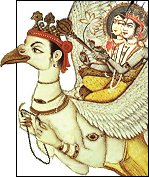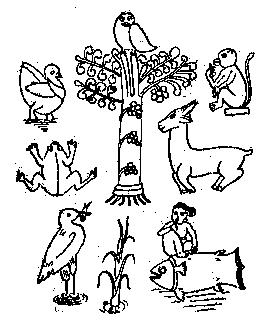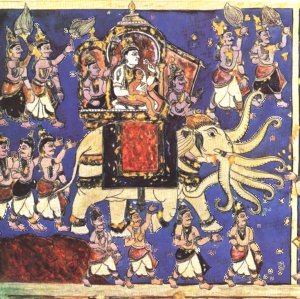Animals of Indian Mythology
Dr. Krishnanand Kamat
Excerpted from The Quarterly
Journal of the Mythic Society Vol. LXXXV Issue 2, June 1994.
First published as
"Attitude of our ancestors towards animals"
Last updated : December 07, 2024
Ancient Indians had recognized the animals' right to co-exist with man and therefore they were loved, nurtured and even worshipped. In order to impress upon the commoners about their importance, the animals were given the status of gods and goddesses. They declared that Almighty incarnates in different animal forms. The kings and the emperors opted different animals in their emblems. Many festivals were/are observed in honor of several animals. In order to inculcate love for animals among children, animals were made heroes in stories. The rulers gave them prime position in art and architecture. Unfortunately, today we are neither adopting ancient Indians' compassionate attitude, nor scientific approach of the westerners towards these animals and hence we are heading towards a catastrophe.
 The activities of ancient Indians were woven around the animals.
Therefore, they knew the happenings of animal world as much as today's ardent student of
zoology. This vast knowledge has been recorded in the scriptures of the time. The Upanishads
contain detailed descriptions of horses and cattle. The Garudapurana contains
life-histories of fishes and turtles. There are also religious books dedicated to a
specific animal. Nagamahdimya, Nandi-purdoa, Mayiratrahimya and Pashu-puriltia are only a
few of them. These writings are older than other scriptures of the world; they contain
very modern concept such as, origin of life, organic evolution and environmental science.
The activities of ancient Indians were woven around the animals.
Therefore, they knew the happenings of animal world as much as today's ardent student of
zoology. This vast knowledge has been recorded in the scriptures of the time. The Upanishads
contain detailed descriptions of horses and cattle. The Garudapurana contains
life-histories of fishes and turtles. There are also religious books dedicated to a
specific animal. Nagamahdimya, Nandi-purdoa, Mayiratrahimya and Pashu-puriltia are only a
few of them. These writings are older than other scriptures of the world; they contain
very modern concept such as, origin of life, organic evolution and environmental science.
Here are a few examples as how animal activities are effectively used to impress the abstract concepts to commoners.
- Almighty is present everywhere but he can't be detected easily just like a silk worm cannot be distinguished from the cocoon that his spun around itself.
- When man becomes united with cosmic God, he cannot be separated from the latter just like pollens cannot be isolated from honey, though it is part of the former.
- Man has to attain moksha by continuously chanting of 'Om' mantra in the way a spider finds its salvation in the web it had woven.
- Immortal soul lives in mortal body for some time and then is reborn in a new body, in the same way as worm keeps on changing its resting place.
- A fickle-minded person is like a wild horse whereas a wise man is like a well trained horse which pulls god's chariot.
- Ultimately man has to seek eternal peace just as ever flying vulture has to rest for some time.
- Chanting of mantras has been compared with the croaking of frogs in the rainy season.
Without any scientific aids, the Indians calculated that the animals came into existence 43,20,000 years ago. On the basis of the major events that took place on the earth, this period is divided into four eras. The Satyayuga lasted for 17,28,000 years; followed by Tretayuga which lasted for 12 96,000 years. The Dwaparayuga was, 8,64,000 years long, whereas Kaliyuga, will be for 4,33,000 years long. The Kali- yuga has commenced in the month of February 3102 B.C. and will come to end in another 4,26,924 years, followed by total destruction of our dear earth by unusual floods. It, is of great interest that the modern zoologists, by using most Sophisticated equipment have come to the conclusion that the earth has passed through four zoological eras, namely Arshean, Paleozoic, Mesozoic and Cenozoic eras.
The Indians also had the concept that any animal can be reproduced and evolved only from pre-existing animal, which is also the hypothesis on which organic evolution theory relies. According to Brihaddraoyaka Upanishad, Virdjan got bored of solitude and adopted binary division like an ameba and became two individuals, one of them acting like male and other the female. As the time passed by, these individuals assumed different animal forms such. as ants, cattle, donkey, goats and pigs. Thus, the whole world was populated by evolving one group of animals into another. However their classification of animal world was on the basis alone, as they did not believe of external forms in killing and dissecting the animals for their study.
The concept of Dashavatara of Lord Vishnu, in a way represents the organic evolution theory. In order to indicate the aquatic origin of the animals, the Lord incarnates in the form of a Mathsya, a fish. This is followed by an amphibious animal Kurma, a turtle. Third incarnation is Varaha, a boar which is completely a terrestrial animal. Narasimha represents a beast's attempt to attain a human form. In Vamana avatar, a pigmy human being is represented. In Parashurama tremendous physical strength could be recognized. In Ramachandra, one can identify perfect human qualities. Krishna is a savior of our environment. Kalki represents our own destruction of giving scant attention to our fauna and environment.
Ancient Indian people were aware of the role played by heredity and environment in the development of an individual. In Yajurveda, a prayer reads, "Give us cows that have abundance of milk, bulls that have full vigor and vitality, horses that can face challenges of any enemy, a ruler who is courageous and fearless, intellectual son and a wife who can take good care of the young and old". Their prayer in Bhiimi-siikta indicates that they had intimate knowledge of different animals ; "In winter protect us from the scorpions and snakes that creep in our dark and moist caves, in rainy season from ferocious boars and bison, in summer from tigers, lions and other man-eating animals" says the prayer.
|
|
There are many instances in our scriptures where ancient Indians had mastered animal languages. While king Kekaya was with his queen, he overheard the conversation of a pair of birds nesting in his courtyard which made, him laugh. He admitted to the queen that he understood birds' talk but refused to share this with others which was a taboo. When the queen insisted to know the contents of the bird's conversation, the king preferred to divorce her on the advice of his guru who had blessed this boon on the king than divulge the code. In Chandogyaupanishat another interesting incident has been mentioned. One evening a pair of cranes were flying back to their place of rest ; the talkative one said to the other that the king Janasbruthi is a very religious and learned person and therefore we must be extra careful while flying over his kingdom. This other crane reacted sharply and asked, "Does this king come anywhere near wisdom of Raikva?" The king overheard this conversation, located Raikva who was relaxing under a bullock cart and learned Bramha-jnana from him.
Two thousand year old Panchatantra contains numerous stories in which the animals have been given prominence. This collection of stories is also the basis for 'Aesop's Fables'. Even today, children as well as adults find great excitement in reading these animal stories. Talkative turtle, stupid frog, rat and lion stories are too well known. Similarly all grandma stories have crows, sparrows, snakes as main characters. The court poets have written numerous collections in which the animal life has been described in minute details. Kalidasa and Bana give a vivid picture of a variety of animals that lived together at ashrams.
Buddhist Jathaka stories attach great importance to rebirth. The elephants and the monkeys come across a variety of animals in different re-births. During his long vanavasa, Lord Rama developed special relations with different animals such as Jatayu, Sugriva, Hanuman, deers and monkeys. Kishkinda of Ramayana now known as Hampi has good population of monkeys even today. Lord Krishna was also an animal lover. In order to protect the animals that he loved, from heavy rains and thunder storm he lifted a huge mountain and came to be known as Govardhana Giridhari.
The emperors, kings and queens adopted different animals as their emblems. The Gangas of Talkadu opted for an elephant, whereas a lion was Kadamba's choice. Hoysala's emblem has a tiger whereas the Vijayanagara kings settled for a boar. Mysore Maharajas went for Ganda-bherunda, two-headed mythical bird. These emblems were printed on flags that were hoisted at the time of different religious functions. Coins of different denominations were minted by embossing these emblems. These emblems were also displayed prominently on temples, forts and palaces.
Because of their minute size, the invertebrates are not given much importance in olden days. However, the Mollusk, the soft bodied shell fishes were considered as very sacred. Lord Vishnu always carried a conch which is an exoskeleton of the animal. A saligrama which is worshipped as a representative of Vishnu, is a fossilized mollusk. Pearl oyster were collected from the sea bed. Among insects, honey-bees, silk-worms and mud-wasps were very well known. Often fish are mentioned in our mythology. Our progenitor, Manu, finds a little golden fish in his folded palms while offering 'Arghya' to the sun god. The frightened fish promises Manu that some, day it will come to his rescue if he let it go now. Fascinated Manu rears the fish in his ashram. When it grows up he first transfers it to a lake and then to the sea. One day the fish brings a warning that, deluge is inevitable and vanishes. When a terrible torpedo hits the sea and land, Manu collects all the animals in a huge boat with an intention to protect them. However frightened animals raise hue and cry and the boat is about to capsize. At that moment the fish appears on the sea and drags the boat to a safe place.
Churning of the ocean by the Suras and Asuras is a very interesting episode in Hindu mythology. They employed Vasuki, a huge poisonous serpent as a rope and Mandara mountain as a churner. In order to prevent the mountain from sinking, Lord Vishnu assumed the form of a turtle and supported it. As a result of this churning, very rare gems like, Kamadhenu, Shankha, Dhanushya, Chandra, Silrya, Dhanwantri, Amritha, Rambha and Laxmi, came out of the ocean. Once Garuda was accompanying his father to Chandraloka. On his way, in the Himalayas, Garuda visits a lake to quench his thirst. To his great surprise he finds in the lake, a tortoise and an elephant fighting each other ferociously. He was at loss to know how to stop them from fighting and hence he feasted on both of them and solved the problem permanently!

Drawing based on a Lepakshi Sculpture.
The crocodile is given prime of place in Hindu religion. It is believed that the Ganga river depends on a crocodile for her very frequent visits to Bay of Bengal from the Himalayan mountains. The rain-god Varuna also rides on Makara. Kamadeva's emblem is Makara and hence his wife carries it whenever she goes. At times the couple takes a joy ride on this animal. In one of the expeditions of Himalayas, Hanuman was bathing in lake when all, of a sudden a huge crocodile clasps his legs. With great difficulty he drags the animal out of water. The cruel animal turns itself into a beautiful damsel and proclaims that because of Daksha's curse she became a crocodile and it is Hanuman's contact that revoked the curse. Similarly, when Hanuman was returning from Lanka his perspiration fell in the mouth of a Nakshtra and she gave birth to Makara Dhwaja. The story of Gajendra Moksha is well known. When the elephant Gajendra visits a pool of water, a under-water crocodile claspses its sharp teeth into one of its hind legs. When the -elephant seeks Lord Vishnu's intervention, the lord kills the crocodile and sets the elephant free.
Kashyapa muni populated the patalaloka. with a variety of snakes. Thus his wife Kadru is considered as the mother of all the snakes. When Janamejaya, wanted to eliminate all the snakes, Takshaka, the king of the serpents with the help of Astika prevented him from doing so. Nagapanchami is an annual festival celebrated in honor of the serpents. Sesha, Visuki and Taksbaka are important representatives of the snake-world. Sesha dedicated himself in the service of Lord Vishnu. Vasuki volunteered himself to be employed for churning of the ocean. When Vishnu incarnated as Krishna, gesha accompanied him as Balarama. It is a very old custom to instal Naga-stones in villages and towns and periodically worship them.
Garuda is an extraordinary son of Kashyapa and Vinata. At the time of his birth, his glowing face made the people think that he is God Agni Himself. The snakes are his favorite snacks. Jatayu and Samprathi are Garuda's two offspring. Pigeons are favorite animals of Kamadeva and Yamaraja. Karthikeya employed peacock for his transportation. Herons are associated with Koushikamuni. Goddess Saraswati always rides a swan. The crow is very well-versed with happening of the heaven and hence people who wish to go to paradise try to please it.
© K. L. Kamat

Lord Indra and his vehicle, the eight trunked Airavat
More Examples of Animals from Indian Mythologies
Deer is associated with innumerable stories. Maricha assumes the form of a golden deer in order to attract Sitadevi. Lord Shiva gets wrapped up in deer skin. Vayus chariot is pulled by a pair of deer. Rishya-shringa was born to a deer which lapped up semen of Vibhandaka. Musk-deer, kasturimriga, is nearest relative of deer. Vashistha gets Kamadhenu for supervising samudra manthana operation. However later on Vishvamitra snatches Kamadhenu from Vasishta. During Parashurama's incarnation, she was in the custody of Jamadagni. Kirtavirya captures her from Jamdagni. Finally she lands with Indra. Cows are Lord Krishna's favorites. Yamadharmaraja always rides a male water-buffallo whenever he intends to visit the earth. Mahishasuramardini is celebrated with all pomp and show, all over the country. Indra employs Ucchaishrava, a snow white horse as his vehicle. Later he changed to Airavata, an elephant with multiple trunks (shown above). Sun god's chariot is pulled by seven red horses.
![]()
See more mythological animals at Kamat's Potpourri
- A Three Headed Mythological Figure Rides a Lion
- Agni the Ram Rider
- Animal Vehicles of Hindu Deities
- Garuda Carrying Lord Vishnu
- Lord Ganesh rides his favorite mouse to earth
- Lord Indra riding the Airavat, the eight trunked elephant
- Lord Krishna Rides the Bird Garuda
- Sports & Utility Vehicles from Heaven
- The Peacock Riding Karthikeyan
- Two Headed Deity Shani Rides a Crow
- Yama the Lord of Death and his Vehicle, the Water Buffalo


